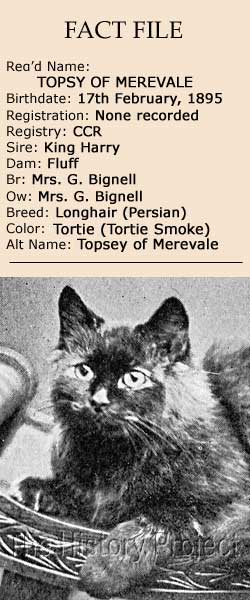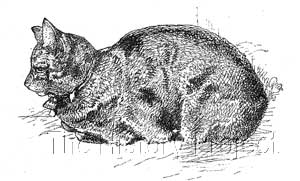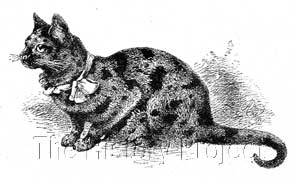 | ||||||||||||








|
TOPSY OF MEREVALE (1895)PHOTOS | SOCIAL MEDIA | REFERENCES
HISTORICAL BACKGROUND:In many respects, the Tortoiseshell Persian began as somewhat of an underdog in the world of pedigreed cats. They seldom, if ever, attained distinction on the show bench. In fact, in the very earliest years of the fancy, the novelty of the 'male Tortoiseshell', invariably short-haired, (which we know today as a genetic 'sport'), is what attracted headlines, so much so, that they usually had a class specifically assigned to them! Owners of Tortie males generally got coverage from the press due to the novelty and rarity of their existence. Sir Claud Alexander at one time owned a number of short-haired Tortie males, but as would be expected, never succeeded in breeding Tortie males from any of them! He did, however, exhibit some fine specimens, among whom were counted 'Ch. Ballochmyle Samson' and 'Ballochmyle Bountiful Bertie'.6 Hence the true tortoiseshell female, either long-haired or short-haired, deserving of recognition in her own right, generally came off a very poor second and was relegated to a lowly status against other colours in the show ring. Among the few early tortie long-hair winners that can be counted, were Mr. Charles Lane's 'Laurel Lulu' (born 1890)6, and Mrs. Driver's 'Queen Elizabeth' (born 1891). The latter, although an excellent specimen, was not a lover of being shown and was equally famous for severely injuring judge Mr. W.R. Hawkins while being assessed for awards. She also bit the hand of Frances Simpson, who at the time was only attempting to move her from her basket to her benching pen at Westminster in 1899!1 Frances Simpson gives a frank and honest opinion of Torties in The Book of the Cat: "Many years ago, when I first took up the cat fancy, I used to think tortoiseshells ugly and commonplace, and I am afraid even now I have not that admiration for the breed which I feel a really good specimen of this variety ought to inspire. To begin with, it is seldom that a true type of long-haired tortoiseshell is seen or exhibited, and perhaps this may account for the breed being so much neglected. They are not taking-looking cats, and make a poor show in the pen. I have often remarked, however, that this is a favourite breed with the sterner sex, and that our professional men judges will almost invariably pick out a tortoiseshell when judging an 'any other colour' class, and give it some mark of distinction. This may be accounted for by the fact that, of all varieties, a really good tortoiseshell is most difficult to breed, and therefore any specimen approaching perfection should be encouraged."1 She continues later, by giving the following opinion on what she considered to be the top show tortoiseshells of the day: "The best three specimens now before the public, are Dr. Roper's 'Dainty Diana', Miss M. Beal's 'Pansy', Miss Kate Sangster's 'Royal Yum Yum', and Mrs. Bignell's 'Topsy of Merevale'."1
PARENTAGE & OWNERSHIP:
Unknown
King Harry
| Unknown
Topsy of Merevale, Feb-17-1895, Tortie (Tortie Smoke), F
| Unknown
Fluff
Unknown
From her listing in the Cat Club Register, 'Topsy' was born 17th February, 1895; sired by Mrs. Herring's 'King Harry' and out of Mrs. Bignell's 'Fluff'. While this appears to be in order, it is in fact ambiguous, as over a period of time Mrs. Herring had registered THREE males with the name of 'King Harry' and two of these were likely contenders as the sire of 'Topsy', both being 'Orange' males. The first is 'King Harry' (NCC: 2272)3, described as an Orange and White, imported, and previously owed by Mrs. Davies. The second contender is 'King Harry' (NCC:3133)3an Orange male, owned by Mrs. Herring, winner of several firsts ad specials. In both cases, their ancestry and breeder are unknown, and their dates of birth are also unrecorded. The dam of 'Topsy', is simply listed as Mrs. Bignell's 'Fluff'. (CCR:Vol.1, Pg16)2. There are 54 different cats named 'Fluff' across the registers, many of which could have been the dam of 'Topsy'. But suffice to say that in the question of the colour of 'Topsy', her dam 'Fluff' is likely to have had a bearing on the colour of her daughter's progeny, which we will touch upon later. Mrs. G. Bignell, The Lodge, Merevale, Bigley Park, Kent, is both the breeder and owner of record.2 A very lovely photograph of 'Topsy" resting on an ornately carved wooden bench, taken by O. Hardee, of Chislehurst, may be found further down in this article. It appeared in the chapter on Tortoiseshell Long-hairs, in The Book of The Cat (1903) by Frances Simpson.1 SIBLINGS & SHOWS:As far as can be ascertained, there are no full siblings of record for 'Topsy', and no sire siblings. The only dam sibling of record is:
On show wins, we find these comments from the pen of Frances Simpson, writing about the best examples of the variety in 1903: "Topsy is a noted prizewinner, and one of her children, 'Lucy Claire', went out to Chicago, and is considered the finest smoke specimen in the American fancy."1 BREEDING & PROGENY:From a litter born: 14th February, 1898; sired by 'Duke of Kent':
Taking into account the photograph of 'Lucy Claire', (alias Baby Flossie), there can be no doubt about her being a smoke, and of particularly good clarity and contrast. Mrs. Clinton Locke had this to say about her 'Lucy': "I consider 'Lucy Claire' - my champion smoke queen - my best cat. She won in England as a kitten at two shows as second and third, with two specials, under the name of Baby Flossie. She has won three firsts and many specials at Chicago, one first and special in Cincinnati, and this year won her fourth first in Chicago with specials. I think she is, by all odds, the best smoke queen in America."5 But…we may surely ask, where did her smoke colouration come from? Her sire, 'Duke of Kent' is registered as a solid 'Blue' and her dam 'Topsy' is registered as a Tortie, not a Tortie Smoke! From the same litter came:
Other progeny include:
From this last litter, we can confirm that 'Topsy' bred correctly as a Tortie carrying dilute. But we still have the mystery of where the silver genes came from in order to regularly produce 'smoke' progeny. When we investigate into the heritage of both parents, we find nothing but contradictions across the registers. In all, 'Duke of Kent' is registered as a Blue (solid), all listings giving his sire as Mrs. Herrings 'Blue Jack'. Some listings give his dam as 'Fluff' and others give his dam as 'Marney'. But in the Cat Club Register, the entry for 'Duke of Kent' himself is unequivocal, the dam is given as 'Marney'. No indications here of any 'smoke' or genes for silver. When we investigate 'Topsy' things get even more complicated. Her sire is 'King Harry' one of two 'Orange'(or 'Orange and White') males, which bodes well for her being listed as a tortie. But neither of these are likely to have been smoke or silver. Which only leaves her dam 'Fluff'. And it's here that we strike great difficulty, as there are some 54 cats named 'Fluff' across the early registers, only six of which have been identified with 'proper' names, many of them having probably been 'pet' names which had filtered through to their pedigrees. A dam sibling of 'Topsy' was 'Lulu of Merevale', a Cream male, sired by 'Duke of Kent'. What this tells us is that for a Cream male to be produced by a Blue sire, the dam had to carry the 'o' gene in her coat. So Fluff had to be either Blue-cream or Tortie. As either, this would fit into her producing 'Topsy' (a dense tortie) when mated to an Orange. But that is where the trail ends. So the answer appeared to be, that we would need to discover whether 'Duke of Kent' had sired any smokes, other than those that he produced with 'Topsy', except where he had been mated to verifiable smokes or silvers. The answer was there were none. Only from his breeding to 'Topsy' were there smokes in the resultant litter. What this tells us is that 'Topsy', although she looks like a straight Tortie in her photograph, was very probably a low-grade tortie-smoke, and if we were able to part her fur, she is likely to have had a base coat of low margin silver. There is no doubt in the writers mind, that the very astute Mrs. Clinton Locke would have seen and known both parents of her 'Baby Flossie' (soon to become) her much beloved 'Lockehaven Lucy Claire'. In support of the 'fact' that 'Topsy' produced the colours she did, when she did, and in supporting her own claims on the propensity of Torties to produce litters comprised of a variety of colours we have a reference to 'Topsy' and her usefulness in this regard, also from the pen of Frances Simpson: "Mrs. Bignell has kindly supplied me with the particulars of 'Topsy's' litters when mated with different coloured cats. 'Topsy's' first litter in 1896, when mated to the 'Duke of Kent' (a Blue), was two creams and two smokes. When mated to 'Johnnie Fawe', (a black), the kittens were all of the father's ducky hue. Again, when crossed with another blue male, her litter consisted of two orange males and a tortoiseshell female, and again to the same cat, one black male and two orange males."1 PHOTOS:
SOCIAL MEDIA :None currently available. In Summary: The story of 'Topsy of Merevale' and in particular, with relevance to her progeny, clarifies for us today, the difficulties experienced by early breeders in registering their cats with only limited knowledge of feline genetics. It is also a reminder that not all colours received equal recognition or attention from breeders. The standard for the Tortie was written with an expectation of a clearly delineated patched cat, without brindling or intermingling, which as we know today, was an exceptionally hard call without the assistance of the white spotting factor to break up the colours. It's fair to say that the rise and appreciation of the Tortoiseshell went hand in hand with the rise in fortune of both reds and red tabbies. As reds improved in type, so did their tortie daughters, and by the time Reds were a dominating force on the show bench, sensible breeders were beginning to assign true value to their Tortie queens all the more. In the modern era, the Tortie has become one of the most valued and appreciated of all breeding options. And in the show ring, they have successfully completed for the highest honours possible. In living memory, Anne & Amanda Bright & Judy Sturm's 'GC, NW Kyina Patience of Oakway' took out a double, firstly achieving the honour of CFA Kitten of the Year for 1978/79, followed by a memorable win as CFA Cat of the Year for 1979/80! Then, almost two decades later Joan & Tom O'Hara's 'GC, NW Araho's Meg Ryan' also attained the distinction of CFA Cat of the Year, for 1997/98.12 The Torties had arrived! And they continue to be an asset and an inspiration to us, to this day. REFERENCES:
Registers associated with this article include the National Cat Club (NCC), The Cat Club (CCR), US Register & Studbook for Cats (USR), The Studbook of the American Cat Association (ACA), and the Studbook & Register of the Cat Fanciers' Association (CFA).
|
|||||||||||
Home | Cats | Clubs | People | Artifacts | Articles | Updates | Contact Us ©The CFA Foundation, Inc and The Harrison Weir Collection
|
||||||||||||




